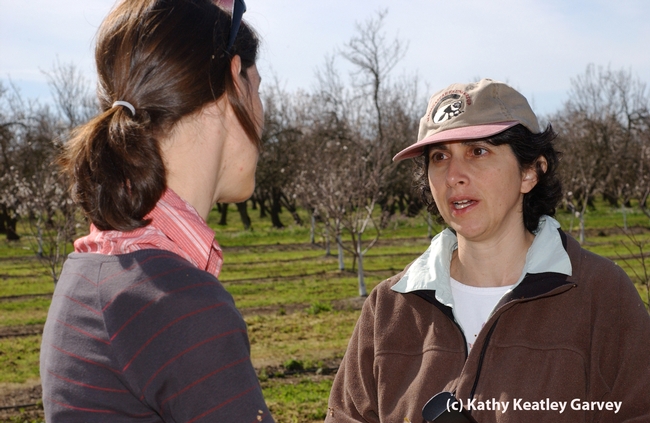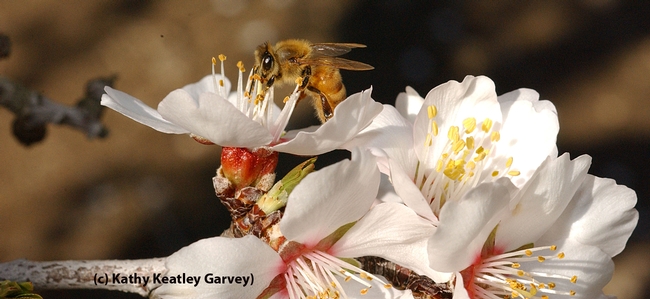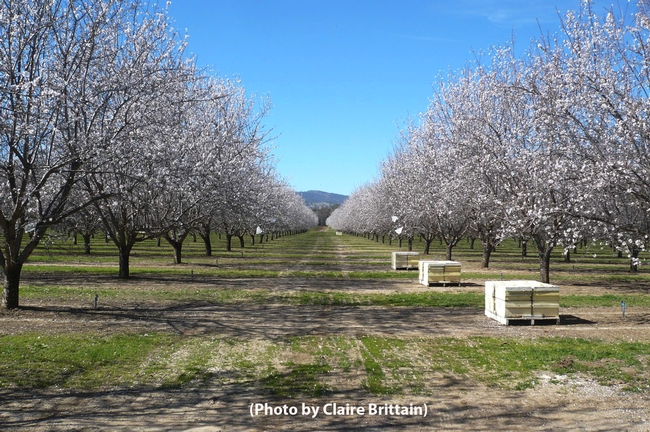
Definitely.
An international research team has been researching honey bee pollination of almonds in the three-county area of Yolo, Colusa and Stanislaus since 2008, and what these scientists have discovered is astounding.
The bottom line: Honey bees are more effective at pollinating almonds when other species of bees are present.
The research, “Synergistic Effects of Non-Apis Bees and Honey Bees for Pollination Services,”published in the Jan. 9th edition of the Proceedings of the Royal Society, could prove invaluable in increasing the pollination effectiveness of honey bees, as demand for their pollination service grows.
So when honey bees are foraging with blue orchard bees and wild bees (such as bumble bees and carpenter bees), the honey bee behavior changes, resulting in more effective crop pollination, says lead author Claire Brittain, a former post-doctoral fellow from Leuphana University of Lüneburg, Germany and now associated with the Neal Williams lab at the University of California, Davis.
“These findings highlight the importance of conserving pollinators and the natural habitats they rely on,” Brittain says. “Not only can they play an important direct role in crop pollination, but we also show that they can improve the pollination service of honey bees in almonds.”
Where did this project originate? In the UC Berkeley lab of conservation biologist/professor Claire Kremen, recipient of a MacArthur Foundation (Genius) Award. Also an associate of the UC Davis Department of Entomology, Kremen works closely with the department's bee scientists at the Harry H. Laidlaw Jr. Honey Bee Research Facility.

Brittain, Kremen, Klein and pollination ecologist Neal Williams, assistant professor of entomology at UC Davis (he joined the team in 2010), co-authored the research.
“This is one of our first demonstrations on how to increase the efficiency of honey bee pollination through diversification of pollinators,” Williams said, pointing out that “With increasing demands for pollination-dependent crops globally, and continued challenges that limit the supply of honey bees, such strategies to increase pollination efficiency offer exciting potential for more sustainable pollination in the future.”
Yes. California’s almond acreage is rapidly increasing. Seems like only a few years ago it was 600,000 acres and now it totals 800,000. Each acre requires two bee hives for pollination, but honey bee-health problems have sparked new concern over pollination services.
As Kremen says: “Almond is a $3 billion industry in California. Our study shows that native bees, through their interactions with honey bees, increase the pollination efficiency of honey bees--the principal bee managed for almond pollination--and thus the amount of fruit set.”
What's next? “The project is ongoing and we plan to investigate further the mechanism behind the increased effectiveness of honey bees when other bees are present,” Brittain says. “We are also going to be looking at how to enhance floral resources for wild bees in almond orchards.”
Meanwhile, watch Professor Klein's UC Davis Department of Entomology seminar, presented in February 2010, when she lectured on “Can Wild Pollinators Contribute, Augment and Complement Almond Pollination in California." It drew widespread interest and a capacity crowd. Click on this link: https://admin.na4.acrobat.com/_a841422360/p37649788/ to hear more.
Attached Images:

UC Berkeley conservation biologist Claire Kremen (right) confers with colleague Alexandria-Marie Klein, then a postdoctoral fellow in her lab. (Photo by Kathy Keatley Garvey).

Honey bee visiting an almond blossom in Arbuckle. (Photo by Kathy Keatley Garvey)

Almond orchard in Capay Valley, Yolo County. (Photo by Claire Brittain)